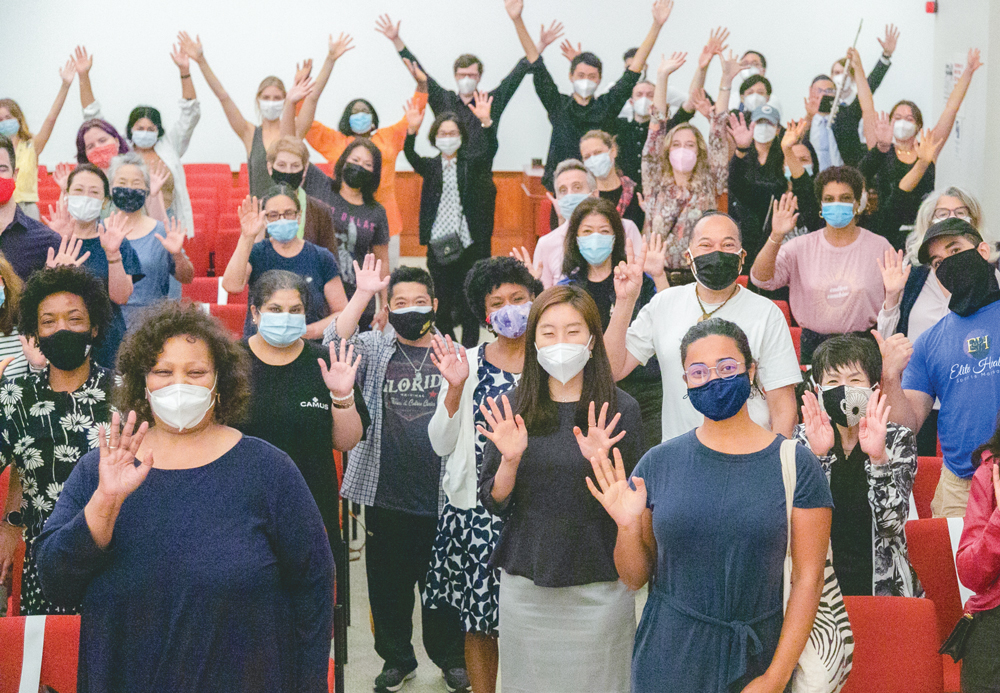What is the purpose of Nichiren Buddhism?
To awaken each person to their fullest potential and help them establish rich, fulfilling, genuinely happy lives. At the same time, its broader goal is to elevate the human condition, to create a harmonious and peaceful society that respects the sanctity of each person’s life.
While individual happiness may seem “doable,” some may see creating peace in today’s chaotic and divisive world as too idealistic. Even if possible, such a grand and noble goal might not be achievable for generations.
To accomplish something of enduring value for humankind requires hope, determination and passionate efforts maintained over successive generations far into the future. That is not and will never be easy. But having someone who has dedicated their life to doing so, who can stand as a model of such commitment and action, is extremely helpful. This is why Buddhism stresses the importance of the mentor-disciple relationship.
All great revolutions have begun with the vision and resolve of one or a few people (mentors). Their efforts may have been hindered by harassment, imprisonment or even death. Yet, in revolutions that succeeded, there have always been disciples who inherited and worked hard to realize their mentor’s vision. Ikeda Sensei explains:
Without the mentor-disciple relationship, anything we undertake just ends with our own lifetime. … In contrast, the mentor-disciple relationship enables us to live a life connected to the great flow of humanity, a life like a mighty river, a life that is part of an unending relay race.
Buddhism teaches the oneness of mentor and disciple. This is not a hierarchy, with the mentor above and the disciple below. Mentor and disciple share the same goal and advance together toward it. …
Mentors and disciples are like runners in a relay race. They are pressing ahead, passing the baton forward on the shared path of justice, happiness and peace for all humanity. The mentors run ahead to later pass the baton to the disciples. (The Wisdom for Creating Happiness and Peace, part 3, p. 176)
Mentor and Disciple: The Way of the Buddha
A Buddha is a person awakened to the truth that all people are equally endowed with the Buddha nature or enlightened nature. Awakened to this truth, to the Mystic Law, the Buddha then strives to make all people aware of it.
A Buddha is not a superhuman or godlike figure but a human being, just like us. Therefore, the relationship between the Buddha and ordinary people is likened to that between a teacher and student, or mentor and disciple.
Unfortunately, in the centuries after Shakyamuni Buddha, this awareness gradually faded and the Buddha became a deified figure. But the Lotus Sutra corrects this mistaken view. The sutra’s second chapter, “Expedient Means,” expresses the Buddha’s resolve “to make all persons equal to me, without any distinction between us” (The Lotus Sutra and Its Opening and Closing Sutras, p. 70). The Buddha, as the mentor, strove to awaken all people, the disciples, to their own Buddhahood.
This simple yet profound teaching of universal enlightenment for all people in the Lotus Sutra was also recognized, taught and spread by Nichiren Daishonin in the 13th century.
And, as the sutra predicted, as Nichiren and his disciples strove to spread this teaching of absolute equality, they faced intense persecution from government and religious authorities determined to keep ordinary people powerless and subservient.
The Lotus Sutra teaches the importance of respecting all human beings and winning over the devilish nature to look down on others.
Based on this spirit, the shared faith and struggle of mentor and disciple is found in striving together to spread the Mystic Law widely. While mentor and disciples are different, unique individuals, they are one and inseparable in the spirit and desire to awaken all people to their true power.
Seeking a Correct Mentor Enables Us to Overcome All Challenges
In Buddhism, it is the disciple who chooses the mentor and takes action in line with the mentor’s example and guidance. It’s important, then, to choose a mentor who correctly practices Buddhism, selflessly dedicates their life to spreading the Law and battles and wins over the negative functions that seek to hinder our efforts to awaken all people to their Buddhahood.
Sensei says, “Correct teachers of the Law can be identified by whether they have encountered hardships and opposition just like those described in the Lotus Sutra” (The Wisdom for Creating Happiness and Peace, part 3, p. 192).
It is through seeking our mentor as an example and making efforts to practice Buddhism for the happiness of self and others that we become people who take action to benefit others, thus achieving a magnificent inner transformation.
Sensei has said:
One person standing up to champion truth—as long as there is one such individual, people will not become confused. Everyone will experience great peace of mind. They will gather in support of that just cause, encouraging one another and advancing together. There is nothing more joyous than this eternal journey of kosen-rufu. There is nothing more exhilarating. (October 2003 Living Buddhism, p. 39)
—Prepared by the SGI-USA Study Department
You are reading {{ meterCount }} of {{ meterMax }} free premium articles

